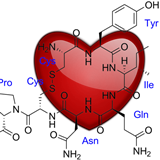
Very little is known about the biological foundations of immoral behavior. Dr. Shaul Shalvi of BGU's Department of Psychology and Carsten K. W. De Dreu of the University of Amsterdam’s Department of Psychology report in an article in Proceedings of the National Academy of Sciences (PNAS) released yesterday (Monday) the results of a double-blind, placebo-controlled experiment showing that the hormone oxytocin promotes group-serving dishonesty.
Compared with participants receiving placebo, participants receiving oxytocin lied more to benefit their groups, did so quicker, and did so without expectation of reciprocal dishonesty from their group members. A control setting ruled out that oxytocin drives self-serving dishonesty. These findings support the functional approach to morality and reveal the underlying biological circuitries associated with group-serving dishonesty.
Oxytocin is a peptide of nine amino acids produced in the hypothalamus, functioning as both a hormone and neurotransmitter. Research has shown that in addition to its bonding effect in couples and between mothers and babies, it also stimulates one’s social approach. More oxytocin correlates with greater empathy, lower social anxiety, more pro-social choice in anonymous games; reduction in fear response; cooperation in single-shot, anonymous games; and trust in interpersonal exchange; it also stimulates defense-related aggression.
Shalvi and De Dreu designed an experiment to test the effects of oxytocin on group-serving dishonesty. 60 male participants were split into teams of 3. They were asked to predict the results of 10 coin tosses. Participants were asked to make a prediction, keep it in their mind, toss the coin, see the outcome and report whether their prediction was correct. Since only participants knew if they predicted correctly, they could lie about it to earn more money. For each correct prediction, participants earned 30 Euro cents to be split between themselves and their two group members who were engaging in the same task. The individual outcome was the team’s outcome divided by three. Before engaging in the task, participants received an intranasal dose of oxytocin or placebo.
The experimenters did not know whether an individual participant was lying or honest, but they could assess how likely it was that participants were honest, given their "success rate" in making the predictions. For example, says Shalvi, “The statistical probability of someone correctly guessing the results of 9 or 10 coin tosses is about 1%. Yet, 53% of those who were given oxytocin claimed to have predicted that many coin tosses. That such a pattern occurred by chance is extremely unlikely."
23% of participants receiving placebo reported correctly predicting 9 or 10 times, also reflecting a high likelihood they were lying, but to a lesser extent compared to those receiving oxytocin. Just to make sure that the experimental results really illustrated lying for the group’s benefit rather than individual benefit, they ran the same experiment with one small change. The individual outcome was based solely on the individual and not on the team’s outcome divided by three. Shalvi and De Dreu found that in that experiment, there was no statistical significance between those who had been given oxytocin and those who had not. It seems that oxytocin promotes lying for the benefit of one’s group.
“Our results suggest people are willing to bend ethical rules to help the people close to us, like our team or family,” says Shalvi, “This raises an interesting although perhaps more philosophical question: Are all lies immoral?”
Shalvi is the director of BGU’s Center for Decision Making and Economic Psychology (DMEP). His research focuses on ethical decision making and the justifications people use to do wrong and still feel moral. Specifically, he looks at what determines how much people lie and which settings increase people’s honesty.
Part of the research was funded by the People Program (Marie Curie Actions) of the European Union’s Seventh Framework Program (FP7/2007-2013) under Research Executive Agency Grant Agreement Number 333745 (to S.S.) and by 432-08-002 of the Netherlands Science Foundation (to C.K.W.D.D.).
